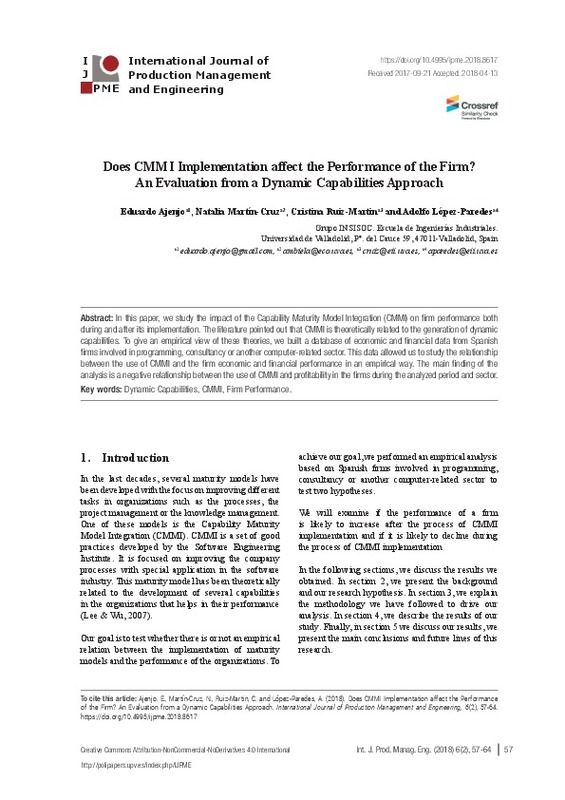Albrecht, J. C., pang, K. (2014). Linking the benefits of project management maturity to project complexity. International Journal of Managing Projects in Business, 7(2), 285-301. https://doi.org/10.1108/IJMPB-08-2013-0040
Andreeva, T., Kianto, A. (2012). Does knowledge management really matter? Linking knowledge management practices, competitiveness, and economic performance. Journal of Knowledge Management, 16, 617-636. https://doi.org/10.1108/13673271211246185
Augier, M., Teece, D. J. (2009). Dynamic Capabilities and the Role of Managers in Business Strategy and Economic Performance. Organization Science, 20(2), 410-421. https://doi.org/10.1287/orsc.1090.0424
[+]
Albrecht, J. C., pang, K. (2014). Linking the benefits of project management maturity to project complexity. International Journal of Managing Projects in Business, 7(2), 285-301. https://doi.org/10.1108/IJMPB-08-2013-0040
Andreeva, T., Kianto, A. (2012). Does knowledge management really matter? Linking knowledge management practices, competitiveness, and economic performance. Journal of Knowledge Management, 16, 617-636. https://doi.org/10.1108/13673271211246185
Augier, M., Teece, D. J. (2009). Dynamic Capabilities and the Role of Managers in Business Strategy and Economic Performance. Organization Science, 20(2), 410-421. https://doi.org/10.1287/orsc.1090.0424
Chien, S., Tsai, C. (2012). Dynamic capability, knowledge, learning, and firm performance. Journal of Organizational Change Management, 25(3), 434-444. https://doi.org/10.1108/09534811211228148
Darroch, J. (2005). Knowledge management, innovation, and firm performance. Journal of Knowledge Management, 9(3), 101-115. https://doi.org/10.1108/13673270510602809
Dayan, R., Evans, S. (2006). KM your way to CMMI. Journal of Knowledge Management, 10(1), 69-80. https://doi.org/10.1108/13673270610650111
de Oliveira Moraes, R., Barbin Laurindo, F. J. (2013). Maturity and Performance in Information Technology Project Management. Journal of Technology Management & Innovation, 8, 5-6. https://doi.org/10.4067/S0718-27242013000300003
Eisenhardt, K. M., Martin, J. A. (2000). Dynamic Capabilities: what are they? Strategic Management Journal, 21, 1105-1121. https://doi.org/10.1002/1097-0266(200010/11)21:10/11%3C1105::AID-SMJ133%3E3.0.CO;2-E
Gibson, D., Goldenson, D., Kost, K. (2006). Performance Results of CMMI-Based Process Improvement.
Goldenson, D., Gibson, D. (2003). Demonstrating the Impact and Benefits of CMMI: An Update and Preliminary Results. Software Engineering Institute. https://doi.org/10.21236/ADA418481
Huang, S. J., Han, W. M. (2006). Selection priority of process areas based on CMMI continuous representation. Information and Management, 43, 297-307. https://doi.org/10.1016/j.im.2005.08.003
Klimko, G. (2001). Knowledge management and maturity models: Building common understanding. In Proceedings of the 2nd European Conference on Knowledge Management (pp. 269-278). Bled, Slovenia.
Kotter, J. P. (2007). Leading Change: Why Transformation Efforts Fail. Harvard Business School Publishing - HBR.
Kruger, C. J. (Neels), Johnson, R. D. (2011). Is there a correlation between knowledge management maturity and organizational performance? VINE, 41(3), 265-295. https://doi.org/10.1108/03055721111171618
Kuriakose, K., Raj, B. (2010). Knowledge management maturity models-a morphological analysis. Journal of Knowledge Management Practice, 11(3).
Lee, J.-F., Wu, M.-J. (2007). Organizational Capabilities Building Through CMMI: the Case of Taiwan Software Industry. Journal of the Chinese Institute of Industrial Engineers, 24(4), 327-339. https://doi.org/10.1080/10170660709509048
Mellert, L. D., Scherbaum, C., Oliveira, J., Wilke, B. (2015). Examining the relationship between organizational change and financial loss. Journal of Organizational Change Management, 28(1), 59-71. https://doi.org/10.1108/JOCM-11-2013-0236
Mullaly, M. (2014). If maturity is the answer, then exactly what was the question? International Journal of Managing Projects in Business, 7(2), 169-185. https://doi.org/10.1108/IJMPB-09-2013-0047
Nenni, M. E., Arnone, V., Boccardelli, P., Napolitano, I. (2014). How to Increase the Value of the Project Management Maturity Model as a Business-oriented Framework. International Journal of Engineering Business Management, 6(1), 1. https://doi.org/10.5772/58292
Niazi, M., Wilson, D., Zowghi, D. (2005). A maturity model for the implementation of software process improvement: An empirical study. Journal of Systems and Software, 74(2005), 155-172. https://doi.org/10.1016/j.jss.2003.10.017
Nielsen, Paarup, A., Paarup, A. (2006). Understanding dynamic capabilities through knowledge management. Journal of Knowledge Management, 10, 59-71. https://doi.org/10.1108/13673270610679363
Reifer, D. J. (2000). The CMMI: it's formidable. Journal of Systems and Software, 50, 97-98. https://doi.org/10.1016/S0164-1212(99)00119-3
Shih, S.-P., Shaw, R.-S., Fu, T.-Y., Cheng, C.-P. (2013). A Systematic Study of Change Management During CMMI Implementation: A Modified Activity Theory Perspective. Project Management Journal, 44(4), 84-100. https://doi.org/10.1002/pmj.21358
Staples, M., Niazi, M. (2008). Systematic review of organizational motivations for adopting CMM-based SPI. Information and Software Technology, 50, 605-620. https://doi.org/10.1016/j.infsof.2007.07.003
Sun, Y., Liu, X. (2010). Business-oriented software process improvement based on CMMI using QFD. Information and Software Technology, 52(1), 79-91. https://doi.org/10.1016/j.infsof.2009.08.003
Tanriverdi, H. (2005). Information technology relatedness knowledge management capability, and performance of multibusiness firms. MIS Quarterly, 29, 311-334. https://doi.org/10.2307/25148681
Teece, D. (2014). The Foundations of Enterprise Performance: Dynamic and Ordinary Capabilities in an (Economic) Theory of Firms. Academy of Management Perspectives, 28(4), 328-352. https://doi.org/10.5465/amp.2013.0116
Teece, D., Pisano, G., Shuen, A. (1997). Dynamic capabilities and strategic management. Strategic Management Journal, 18(7), 509-533. https://doi.org/10.1002/(SICI)1097-0266(199708)18:7%3C509::AID-SMJ882%3E3.0.CO;2-Z
Tseng, S.-M., Lee, P.-S. (2014). The effect of knowledge management capability and dynamic capability on organizational performance. Journal of Enterprise Information Management, 27(2), 158-179. https://doi.org/10.1108/JEIM-05-2012-0025
Wu, Q., He, Q., Duan, Y. (2013). Explicating dynamic capabilities for corporate sustainability. EuroMed Journal of Business, 8(3), 255-272. https://doi.org/http://dx.doi.org/10.1108/EMJB-05-2013-0025
Young, M., Young, R., Romero Zapata, J. (2014). Project, programme and portfolio maturity: a case study of Australian Federal Government. International Journal of Managing Projects in Business, 7(2), 215-230. https://doi.org/10.1108/IJMPB-08-2013-0034
Zack, M., McKeen, J., Singh, S. (2009). Knowledge management and organizational performance: an exploratory analysis. Journal of Knowledge Management, 13(6), 392-409. https://doi.org/10.1108/13673270910997088
Zheng, S., Zhang, W., Du, J. (2011). Knowledge-based dynamic capabilities and innovation in networked environments. Journal of Knowledge Management, 15, 1035-1051. https://doi.org/10.1108/13673271111179352
[-]








